Meetings for Winter 2021.
We will be meeting Thursdays at 10AM via Zoom. Contact Prof. Stiber for the URL. Prospective lab members are welcome to attend!
AI and graph-based systems.
We will be meeting Thursdays at 10AM via Zoom. Contact Prof. Stiber for the URL. Prospective lab members are welcome to attend!
We have successfully earned a one-year grant (with an option to extend to a second year) from the US National Security Agency to build an intelligent testbed to model next-generation 911 communications services and to analyze their behaviors. This testbed will be built on top of our new BrainGrid simulator (see the news about our summer 2020 activities). There's a very nice news article about this on the UW Bothell news page. We will need to come up with a new name for the simulator, since we'll be using it to simulate a larger variety of graph-based systems.
We spent summer 2020 paying down technical debt on the BrainGrid simulator. The new simulator incorporates a variety of new architectural design patterns that will make it much easier to modify and extend its capabilities. In addition, the Workbench is being overhauled with respect to its UI and execution of the simulator. Expect a "great switch" of GitHub repositories in late fall as the new architecture becomes the production system. This great work was accomplished by undergrads Chris O'Keefe and Lizzy Presland, grad students Joe Conquest, Tori Salvatore, and Snigdha Singh, and high school student Karthik Vetrivel.
We had two students successfully defend their Masters theses/projects in spring:
Undergraduate capstone projects for 2019:
Undergraduate capstone projects for 2018:
Fumitaka Kawasaki finalized testing of the new version of BrainGrid, which allows for multiple threads of execution on the CPU and utilization of multiple GPUs in a simulation. We've tested this on the four GPUs on Raiju, and it enables significantly larger simulations.
Our new machine, Otachi, was added to the lab. This Xeon-based machine includes two NVIDIA V-100 GPUs.

We have successfully bid on hosting the 2020 Neural Coding meeting! This will bring around 100 computational, mathematical, and experimental neuroscientists from around the world to the UW Bothell campus during that summer.
Lee, J.Y.H. and M. Stiber, "Spatiotemporal characteristics of bursting and avalanches in cultures of cortical neurons", Neural Coding 2018, Turin, Italy, September 9–14, 2018.

Podium in the meeting room, with University of Turin seal. Unfortunately, Prof. Stiber doesn't have a photo of himself presenting.
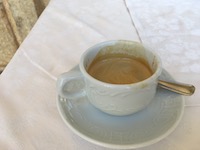
A long trip means jet lag, and jet lag means coffee, in the home of espresso.
Jewel YunHsuan Lee with her poster at the 2018 IEEE Engineering in Medicine and Biology Conference.
Kostal, L., P. Lansky, and M. Stiber, "Statistics of inverse interspike intervals: the instantaneous firing rate revisited", Chaos, 2018, in press.
Another very successful MS defense, this time by Jewel Lee for her thesis, "Machine Learning of Spatiotemporal Bursting Behavior in Developing Neural Networks". In her work, she developed an entire suite of data analysis tools for identifying features of interest in spatiotemporal point processes — in particular, for large numbers of simultaneous neural spike trains. She applied this to BrainGrid simulation results (consisting of 30GB HDF5 files), leading to the discovery of a number of novel features that will be reported on in upcoming conference presentations and journal papers. Stay tuned!
Tom Wong defended his MS project on March 8. His project, "Workbench Dashboard — Managing Experiments using Data and Software Provenance", developed a new user interface for our Workbench project that visualizes the interrelationships among simulation artifacts, including software, git commits, parameter files, and results files.
As promised, Prof. Stiber is posting updates from his time as a Fulbright Scholar in Europe:
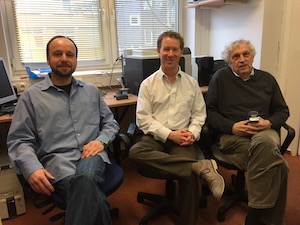
Prof. Stiber with his hosts in the Computational Neuroscience department of the Institute of Physiology of the Czech Academy of Sciences: Lubomir Košťál, Ph.D. (l) and Petr Lánský, Ph.D. (r).
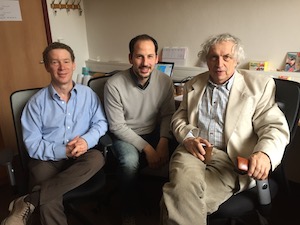
Prof. Stiber with Giuseppe D'Onofrio, Ph.D. (c) and Petr Lánský, Ph.D. (r).
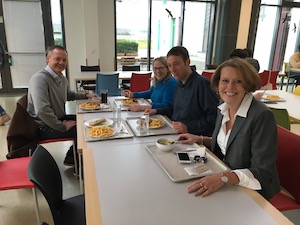
Meeting with colleagues at the University of Applied Sciences in Mainz, Germany. School cafeterias are the actual, true universal constant.
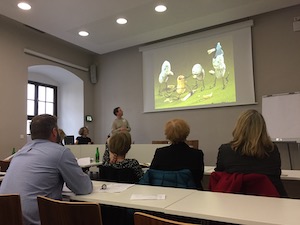
Presenting zombie-peanut-related (not to be confused with peanut-zombie-related) neuroscience research at the Fulbright mid-year meeting in Třešť, Czech Republic.

Lunch with Prof. Maurizio Atzori, from the Univ. of Cagliari in Italy. Prof. Stiber was invited to talk, with funding from the university and the Italian Fulbright Commission. Sorry, no gripping photos of the presentation itself.
Stiber, M., F. Kawasaki, D. Davis, H.U. Asuncion, J.Y.H. Chu, and D. Boyer, "BrainGrid+Workbench: High-Performance/High-Quality Neural Simulation," Proc. International Joint Conference on Neural Networks, Anchorage, Alaska, May 14–19, 2017.

Coffee being turned into science!
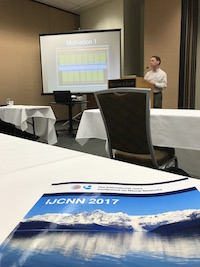
Prof. Stiber presenting the obligatory GPU figure.
Prof. Stiber received a Fulbright Scholar Award to visit the Czech Academy of Sciences in Prague, to collaborate on neural coding research with colleagues in their Institute of Physiology's department of computational neuroscience. He will be there during winter quarter 2018 and promises to post regular updates.
Stiber, M., F. Kawasaki, M. Strange, and A. Watson, "Bringing high performance neural simulation to the desktop with BrainGrid", Proc. International Workshop on Neuronal Coding, Cologne, Germany, August 29 – September 2, 2016.
Profs. Stiber and Asuncion earned a UW Bothell CSS Research Assistantship Grant
Stiber, M., B.Z. Stiber, and E.C. Larson, Signal Computing: Digital Signals in the Software Domain.
Kawasaki, F. and M. Stiber, "A simple model of cortical culture growth: burst property dependence on network composition and activity", Biological Cybernetics 108(4): 423-443, 2014.
Kawasaki, F. and M. Stiber, "Growing neural networks with GPUs", Osaka University, October 2014.
Kawasaki, F. and M. Stiber, "Stimulation effects on cortical culture development", International Conference on Cognitive Neurodynamics, Sigtuna, Sweden, June 23-27, 2013.
Kawasaki, F. and M. Stiber, "Bursting behavior in a large-scale model of cortical network development", BIOCOMP 2012 Mathematical Modeling and Computational Topics in Biosciences, Vietri sul Mare, Italy, June 4-8, 2012.
F. Kawasaki, "Accelerating large-scale simulations of cortical neuronal network development"
In collaboration with Prof. Kelvin Sung, the laboratory has earned a Professor Partnership Grant with NVIDIA Corporation for general-purpose graphics processing unit (GPU) high-performance computing hardware.
Sean McCallum, "Pendant EEG: A Brain-Computer Interface"
Ramamurthy, K., A. Spanias, L. Hinnov, C. Akujuobi, M. Stiber, M. Pattichis, E. Doering, C. Pattichis, H. Thornburg, A. Papandreou-Suppappola, P. Spanias, R. Ayyanar, E. Campana, S. Haag, "Work in Progress --- Collaborative Multi-Disciplinary J-DSP Software Project", 39th ASEE/IEEE Frontiers in Education Conference, San Antonio, October 18-21, 2009.
Prof. Stiber has been appointed Director of the Computing and Software Systems Program. May God have mercy on his soul.
The BCL and collaborators at Arizona State University, Johns Hopkins University, and Prarie View A&M University secured a $1.2 million grant from the National Science Foundation for "Design, Implementation and Dissemination of Multidisciplinary online Java Digital Signal Processing (J-DSP) Materials"
Prof. Stiber, along with UWB colleagues Prof. Steven Collins and Prof. Alan Leong, have formed the UWB Biotechnology and Biomedical Technology Institute (BBTI) as an interface between resources and events at UWB and the area life sciences industry.
Prof. Stiber has been named a Fulbright Senior Specialists Roster Candidate for the years 2008-2013 by the Council for International Exchange of Scholars.
The BCL, in collaboration with the UWB CSS Distributed Systems Lab, earned a $4,000 UWB Collaborative Undergraduate Research project grant to support the development of gridware for neural simulation.
Our web site now has a new look, thanks to the efforts of Jeevan Vaikunthanathan from Brian Bansenauer's BIT 113 class at Cascadia Community College.
Michael Stiber, Fumitaka Kawasaki, and Dongming Xu, "A model of dissociated cortical tissue", International Workshop on Neuronal Coding, Montevideo, Uruguay, November 2007.
Summary: This is the first of a new line of investigation for the BCL. We are interested in understanding how developing brains form networks that perform useful tasks. One method that a number of investigators are using is growing cultures of "dissociated cortical tissue" -- brain cells from fetal rats -- on electrode arrays. The idea is to be able to probe networks as they develop. Unfortunately, what usually results is a network that produces large bursts of activity and little else. We now have a model of a small network that we used for a preliminary evaluation of how such activity might arise.
We received a grant (OISE-0652336) from the National Science Foundation for a "Joint US/Uruguay Workshop on Neuronal Coding", to be just before the International Workshop on Neuronal Coding in Montevideo, in November 2007.
Michael Stiber, "Transient bifurcations in neural error correction," Biosystems 89(1-3): 24-29, May-June 2007.
Summary: This paper continues our investigation into the significance of timing in nerve cells and, in particular, the possibility of error correcting codes. In this case, we looked at the interplay between errors and the kind of behavior a cell exhibits. We showed that we can predict the aftereffects of an error using our knowledge of a cell's nonlinear dynamics.
The BCL received a $2,000 UWB Collaborative Undergraduate Research project grant, "Liquid state machines as models of cortical cultures."
Prof. Stiber is on the organizing committee for the Neural Coding 2007 meeting in Montevideo, Uruguay.
Prof. Stiber and the BCL became a partner in the creation of a Biotechnology and Biomedical Technology Institute at UWB. Among other things, this new institute will help connect BCL research and students to local industry. Creation of the BBTI is supported by a $20,000 UWB Worthington Academic Distinction grant.
We now have a local copy of the J-DSP software installed. This is in preparation for its incorporation into the Spring 2006 edition of our Multimedia Computing course.
Prof. Stiber is back from his sabbatical at the University of Florida Electrical and Computer Engineering Department's Computational Neuroengineering Laboratory.
Conference paper: Spanias, A., V. Atti, R. Chilimula, S. Haag, A. Papandreou-Suppappola, C. Tepedelenlioglu, J. Zhang, F. Bodreaux-Bartels, M. Stiber, T. Kasparis, and P Loizou, "Work in Progress - Multi-university development and dissemination of online laboratories in probability theory, signals and systems, and multimedia computing", IEEE Frontiers in Education, Indianapolis, October 2005.
Stiber, M. "Bifurcations of neural transient responses", International Workshop on Neuronal Coding, Marburg, Germany, August 2005.
The Biocomputing Laboratory has received a $200,000 grant from the National Science Foundation in collaboration with Arizona State University, the University of Texas, Dallas, and the University of Rhode Island. This support will be used to develop a set of on-line computer laboratory modules and study materials for the lab's digital signal computing course for software majors.
Summary: One of the open questions in neural computation is how important the timing of nerve cell outputs is. Our research shows that it is plausible that nerve cells could use high-precision outputs as a type of error correcting code. Besides addressing questions in biocomputing, this could have applications to pulse-coded and secure communications.
Summary: One of the difficulties facing people investigating biocomputing is that of high connectivity: each nerve cell typically sends and receives outputs and inputs to and from thousands of other cells. In this work, we apply the concept of cluster point processes to analyzing the responses of nerve cells to large numbers of inputs.
Prof. Stiber is a Visiting Associate Professor in the University of Florida Electrical and Computer Engineering Department's Computational Neuroengineering Laboratory for the academic year. While there, he has been working on models of nervous system formation for cortical cell cultures: living nervous system tissue grown in "petri dishes". These cultures show promise as tools for investigating neurological diseases like epilepsy. They also serve as the basic building blocks of a new generation of hybrid biological/electronic computing devices.
Summary: This work with a UWB student continues our investigation of error correction in biocomputing by examining the detailed internal dynamics of a single nerve cell in response to individual inputs. We hope to use this information to build a more general model for information coding in nervous systems that takes into account timing precision and errors.
Summary: This work, also with a UWB student, takes a broad view of the issue of nerve cell error correction. It shows how techniques previously used for "static" neural behaviors can be extended to aid our understanding of error correction.
Summary: We have been developing a laboratory course that introduces the concepts of computing with real-world signals to UWB students. These are topics that are usually covered in an electrical engineering curriculum. In the BCL course, students learn the software and systems issues related to digital signal computing.